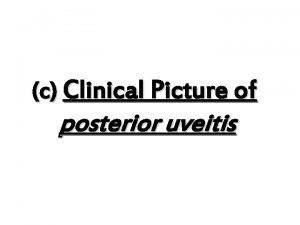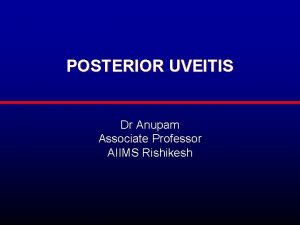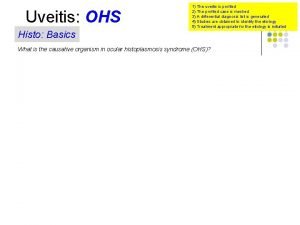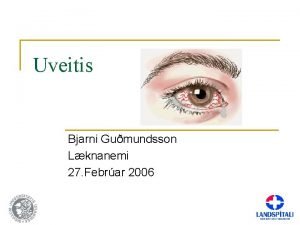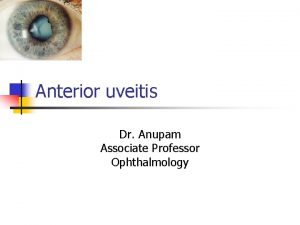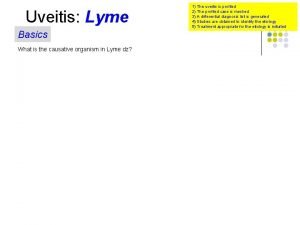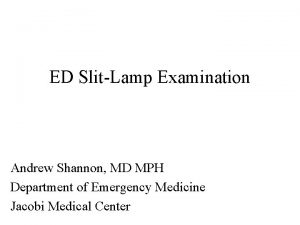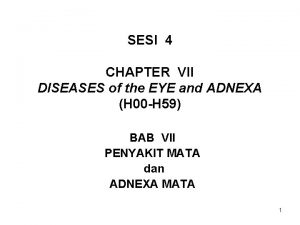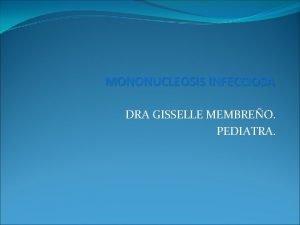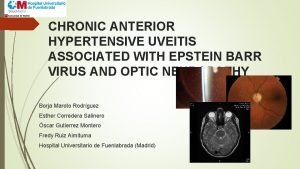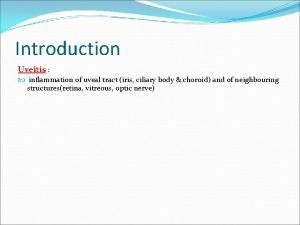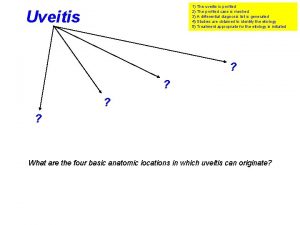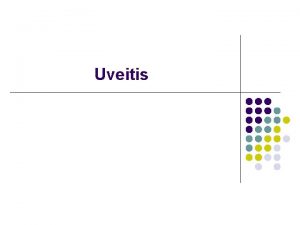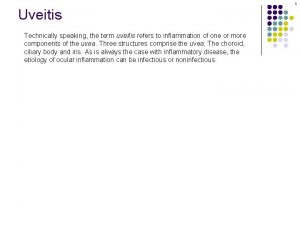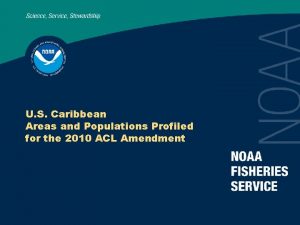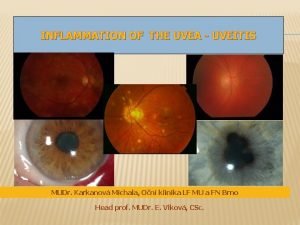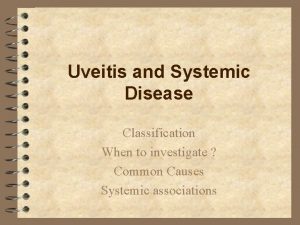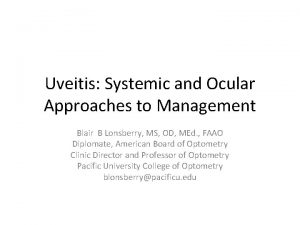1 The uveitis is profiled 2 The profiled
























































































- Slides: 88

1) The uveitis is profiled 2) The profiled case is meshed 3) A differential diagnosis list is generated 4) Studies are obtained to identify the etiology 5) Treatment appropriate for the etiology is initiated Uveitis ? ? What are the four basic anatomic locations for uveitis?

1) The uveitis is profiled 2) The profiled case is meshed 3) A differential diagnosis list is generated 4) Studies are obtained to identify the etiology 5) Treatment appropriate for the etiology is initiated Uveitis Panuveitis Posterior Intermediate Anterior What are the four basic anatomic locations for uveitis?

Uveitis 1) The uveitis is profiled 2) The profiled case is meshed 3) A differential diagnosis list is generated 4) Studies are obtained to identify the etiology 5) Treatment appropriate for the etiology is initiated Panuveitis Posterior Intermediate Anterior What is the hallmark of intermediate uveitis (IU)?

Uveitis 1) The uveitis is profiled 2) The profiled case is meshed 3) A differential diagnosis list is generated 4) Studies are obtained to identify the etiology 5) Treatment appropriate for the etiology is initiated Panuveitis Posterior Intermediate Anterior What is the hallmark of intermediate uveitis (IU)? The inflammation is located principally in the anterior vitreous, and usually involves the vitreous base

1) The uveitis is profiled 2) The profiled case is meshed 3) A differential diagnosis list is generated 4) Studies are obtained to identify the etiology 5) Treatment appropriate for the etiology is initiated Uveitis Panuveitis Posterior Intermediate Anterior What is the hallmark of intermediate uveitis (IU)? The inflammation is located principally in the anterior vitreous, and usually involves the vitreous base The vitreous base straddles/adheres to what structure? The ora serrata What is the ora serrata? It is the zone where the peripheral retina meets the pars plana of the ciliary body

1) The uveitis is profiled 2) The profiled case is meshed 3) A differential diagnosis list is generated 4) Studies are obtained to identify the etiology 5) Treatment appropriate for the etiology is initiated Uveitis Panuveitis Posterior Intermediate Anterior What is the hallmark of intermediate uveitis (IU)? The inflammation is located principally in the anterior vitreous, and usually involves the vitreous base The vitreous base straddles/adheres to what structure? The ora serrata What is the ora serrata? It is the zone where the peripheral retina meets the pars plana of the ciliary body

1) The uveitis is profiled 2) The profiled case is meshed 3) A differential diagnosis list is generated 4) Studies are obtained to identify the etiology 5) Treatment appropriate for the etiology is initiated Uveitis Panuveitis Posterior Intermediate Anterior What is the hallmark of intermediate uveitis (IU)? The inflammation is located principally in the anterior vitreous, and usually involves the vitreous base The vitreous base straddles/adheres to what structure? The ora serrata What is the ora serrata? It is the zone where the peripheral retina meets the pars plana of the ciliary body

1) The uveitis is profiled 2) The profiled case is meshed 3) A differential diagnosis list is generated 4) Studies are obtained to identify the etiology 5) Treatment appropriate for the etiology is initiated Uveitis Panuveitis Posterior Intermediate Anterior What is the hallmark of intermediate uveitis (IU)? The inflammation is located principally in the anterior vitreous, and usually involves the vitreous base The vitreous base straddles/adheres to what structure? The ora serrata What is the ora serrata? It is the zone where the peripheral retina meets the pars plana of the ciliary body

ora serrata 9

Uveitis 1) The uveitis is profiled 2) The profiled case is meshed 3) A differential diagnosis list is generated 4) Studies are obtained to identify the etiology 5) Treatment appropriate for the etiology is initiated Panuveitis Posterior Intermediate Anterior What is the hallmark of intermediate uveitis (IU)? The inflammation is located principally in the anterior vitreous, and usually involves the vitreous base Does IU present with anterior-chamber cell?

Uveitis 1) The uveitis is profiled 2) The profiled case is meshed 3) A differential diagnosis list is generated 4) Studies are obtained to identify the etiology 5) Treatment appropriate for the etiology is initiated Panuveitis Posterior Intermediate Anterior What is the hallmark of intermediate uveitis (IU)? The inflammation is located principally in the anterior vitreous, and usually involves the vitreous base Does IU present with anterior-chamber cell? Generally no. When present, AC cell is usually mild, and is generally believed to be ‘spillover’ from the vitreous.

Uveitis 1) The uveitis is profiled 2) The profiled case is meshed 3) A differential diagnosis list is generated 4) Studies are obtained to identify the etiology 5) Treatment appropriate for the etiology is initiated Panuveitis Posterior Intermediate Anterior What is the hallmark of intermediate uveitis (IU)? The inflammation is located principally in the anterior vitreous, and usually involves the vitreous base Does IU present with anterior-chamber cell? Generally no. When present, AC cell is usually mild, and is generally believed to be ‘spillover’ from the vitreous. In this context, what are snowballs and snowbanking?

Uveitis 1) The uveitis is profiled 2) The profiled case is meshed 3) A differential diagnosis list is generated 4) Studies are obtained to identify the etiology 5) Treatment appropriate for the etiology is initiated Panuveitis Posterior Intermediate Anterior What is the hallmark of intermediate uveitis (IU)? The inflammation is located principally in the anterior vitreous, and usually involves the vitreous base Does IU present with anterior-chamber cell? Generally no. When present, AC cell is usually mild, and is generally believed to be ‘spillover’ from the vitreous. In this context, what are snowballs and snowbanking? Snowballs are clumped inflammatory cells in the vitreous Snowbanking refers to the appearance of large swaths of accumulated inflammatory debris along the inferior pars plana

Snowballs in intermediate uveitis

Snowbanking in intermediate uveitis

Uveitis: Intermediate ? (subtype of intermediate uveitis) Intermediate uveitis 1) The uveitis is profiled 2) The profiled case is meshed 3) A differential diagnosis list is generated 4) Studies are obtained to identify the etiology 5) Treatment appropriate for the etiology is initiated

Uveitis: Intermediate Pars planitis (subtype of intermediate uveitis) Intermediate uveitis 1) The uveitis is profiled 2) The profiled case is meshed 3) A differential diagnosis list is generated 4) Studies are obtained to identify the etiology 5) Treatment appropriate for the etiology is initiated

Uveitis: Intermediate Pars planitis 1) The uveitis is profiled 2) The profiled case is meshed 3) A differential diagnosis list is generated 4) Studies are obtained to identify the etiology 5) Treatment appropriate for the etiology is initiated Intermediate uveitis When is intermediate uveitis, and when is it pars planitis?

Uveitis: Intermediate Pars planitis 1) The uveitis is profiled 2) The profiled case is meshed 3) A differential diagnosis list is generated 4) Studies are obtained to identify the etiology 5) Treatment appropriate for the etiology is initiated Intermediate uveitis When is intermediate uveitis, and when is it pars planitis? It is considered intermediate uveitis when it is associated with either a local infection or a systemic condition; otherwise it is pars planitis

Uveitis: Intermediate Pars planitis Intermediate uveitis At what age(s) is/are pars planitis (PP) most likely to present? 1) The uveitis is profiled 2) The profiled case is meshed 3) A differential diagnosis list is generated 4) Studies are obtained to identify the etiology 5) Treatment appropriate for the etiology is initiated

Uveitis: Intermediate Pars planitis 1) The uveitis is profiled 2) The profiled case is meshed 3) A differential diagnosis list is generated 4) Studies are obtained to identify the etiology 5) Treatment appropriate for the etiology is initiated Intermediate uveitis At what age(s) is/are pars planitis (PP) most likely to present? #-# The age-of-incidence for PP is bimodal, with one peak in the 5 -15 year-old range, and another in the #-# 20 -40 y. o. range

Uveitis: Intermediate Pars planitis 1) The uveitis is profiled 2) The profiled case is meshed 3) A differential diagnosis list is generated 4) Studies are obtained to identify the etiology 5) Treatment appropriate for the etiology is initiated Intermediate uveitis At what age(s) is/are pars planitis (PP) most likely to present? The age-of-incidence for PP is bimodal, with one peak in the 5 -15 year-old range, and another in the 20 -40 y. o. range

Uveitis: Intermediate Pars planitis 1) The uveitis is profiled 2) The profiled case is meshed 3) A differential diagnosis list is generated 4) Studies are obtained to identify the etiology 5) Treatment appropriate for the etiology is initiated Intermediate uveitis At what age(s) is/are pars planitis (PP) most likely to present? The age-of-incidence for PP is bimodal, with one peak in the 5 -15 year-old range, and another in the 20 -40 y. o. range Is there a gender predilection?

Uveitis: Intermediate Pars planitis 1) The uveitis is profiled 2) The profiled case is meshed 3) A differential diagnosis list is generated 4) Studies are obtained to identify the etiology 5) Treatment appropriate for the etiology is initiated Intermediate uveitis At what age(s) is/are pars planitis (PP) most likely to present? The age-of-incidence for PP is bimodal, with one peak in the 5 -15 year-old range, and another in the 20 -40 y. o. range Is there a gender predilection? No

Uveitis: Intermediate Pars planitis 1) The uveitis is profiled 2) The profiled case is meshed 3) A differential diagnosis list is generated 4) Studies are obtained to identify the etiology 5) Treatment appropriate for the etiology is initiated Intermediate uveitis At what age(s) is/are pars planitis (PP) most likely to present? The age-of-incidence for PP is bimodal, with one peak in the 5 -15 year-old range, and another in the 20 -40 y. o. range Is there a gender predilection? No What is the typical presenting complaint?

Uveitis: Intermediate Pars planitis 1) The uveitis is profiled 2) The profiled case is meshed 3) A differential diagnosis list is generated 4) Studies are obtained to identify the etiology 5) Treatment appropriate for the etiology is initiated Intermediate uveitis At what age(s) is/are pars planitis (PP) most likely to present? The age-of-incidence for PP is bimodal, with one peak in the 5 -15 year-old range, and another in the 20 -40 y. o. range Is there a gender predilection? No What is the typical presenting complaint? Children/teens often present in a manner similar to acute anterior uveitis: Pain, injection and photophobia.

Uveitis: Intermediate Pars planitis 1) The uveitis is profiled 2) The profiled case is meshed 3) A differential diagnosis list is generated 4) Studies are obtained to identify the etiology 5) Treatment appropriate for the etiology is initiated Intermediate uveitis At what age(s) is/are pars planitis (PP) most likely to present? The age-of-incidence for PP is bimodal, with one peak in the 5 -15 year-old range, and another in the 20 -40 y. o. range Is there a gender predilection? No What is the typical presenting complaint? Children/teens often present in a manner similar to acute anterior uveitis: Pain, injection and photophobia.

Uveitis: Intermediate Pars planitis 1) The uveitis is profiled 2) The profiled case is meshed 3) A differential diagnosis list is generated 4) Studies are obtained to identify the etiology 5) Treatment appropriate for the etiology is initiated Intermediate uveitis At what age(s) is/are pars planitis (PP) most likely to present? The age-of-incidence for PP is bimodal, with one peak in the 5 -15 year-old range, and another in the 20 -40 y. o. range Is there a gender predilection? No What is the typical presenting complaint? Children/teens often present in a manner similar to acute anterior uveitis: Pain, injection and photophobia. Adult-onset PP typically presents more insidiously, with a chief complaint of floaters.

Uveitis: Intermediate Pars planitis 1) The uveitis is profiled 2) The profiled case is meshed 3) A differential diagnosis list is generated 4) Studies are obtained to identify the etiology 5) Treatment appropriate for the etiology is initiated Intermediate uveitis At what age(s) is/are pars planitis (PP) most likely to present? The age-of-incidence for PP is bimodal, with one peak in the 5 -15 year-old range, and another in the 20 -40 y. o. range Is there a gender predilection? No What is the typical presenting complaint? Children/teens often present in a manner similar to acute anterior uveitis: Pain, injection and photophobia. Adult-onset PP typically presents more insidiously, with a chief complaint of floaters.

Uveitis: Intermediate Pars planitis 1) The uveitis is profiled 2) The profiled case is meshed 3) A differential diagnosis list is generated 4) Studies are obtained to identify the etiology 5) Treatment appropriate for the etiology is initiated Intermediate uveitis At what age(s) is/are pars planitis (PP) most likely to present? The age-of-incidence for PP is bimodal, with one peak in the 5 -15 year-old range, and another in the 20 -40 y. o. range Is there a gender predilection? No What is the typical presenting complaint? Children/teens often present in a manner similar to acute anterior uveitis: Pain, injection and photophobia. Adult-onset PP typically presents more insidiously, with a chief complaint of floaters. Does PP tend to present unilaterally, or bilaterally?

Uveitis: Intermediate Pars planitis 1) The uveitis is profiled 2) The profiled case is meshed 3) A differential diagnosis list is generated 4) Studies are obtained to identify the etiology 5) Treatment appropriate for the etiology is initiated Intermediate uveitis At what age(s) is/are pars planitis (PP) most likely to present? The age-of-incidence for PP is bimodal, with one peak in the 5 -15 year-old range, and another in the 20 -40 y. o. range Is there a gender predilection? No What is the typical presenting complaint? Children/teens often present in a manner similar to acute anterior uveitis: Pain, injection and photophobia. Adult-onset PP typically presents more insidiously, with a chief complaint of floaters. Does PP tend to present unilaterally, or bilaterally? It is bilateral in 80% of cases (but it is often quite asymmetric in severity) %

Uveitis: Intermediate Pars planitis 1) The uveitis is profiled 2) The profiled case is meshed 3) A differential diagnosis list is generated 4) Studies are obtained to identify the etiology 5) Treatment appropriate for the etiology is initiated Intermediate uveitis At what age(s) is/are pars planitis (PP) most likely to present? The age-of-incidence for PP is bimodal, with one peak in the 5 -15 year-old range, and another in the 20 -40 y. o. range Is there a gender predilection? No What is the typical presenting complaint? Children/teens often present in a manner similar to acute anterior uveitis: Pain, injection and photophobia. Adult-onset PP typically presents more insidiously, with a chief complaint of floaters. Does PP tend to present unilaterally, or bilaterally? It is bilateral in 80% of cases (but it is often quite asymmetric in severity)

Uveitis: Intermediate Pars planitis 1) The uveitis is profiled 2) The profiled case is meshed 3) A differential diagnosis list is generated 4) Studies are obtained to identify the etiology 5) Treatment appropriate for the etiology is initiated Intermediate uveitis At what age(s) is/are pars planitis (PP) most likely to present? The age-of-incidence for PP is bimodal, with one peak in the 5 -15 year-old range, and another in the 20 -40 y. o. range Is there a gender predilection? No What is the typical presenting complaint? Children/teens often present in a manner similar to acute anterior uveitis: Pain, injection and photophobia. Adult-onset PP typically presents more insidiously, with a chief complaint of floaters. Does PP tend to present unilaterally, or bilaterally? It is bilateral in 80% of cases (but it is often quite asymmetric in severity) Is PP a benign condition?

Uveitis: Intermediate Pars planitis 1) The uveitis is profiled 2) The profiled case is meshed 3) A differential diagnosis list is generated 4) Studies are obtained to identify the etiology 5) Treatment appropriate for the etiology is initiated Intermediate uveitis At what age(s) is/are pars planitis (PP) most likely to present? The age-of-incidence for PP is bimodal, with one peak in the 5 -15 year-old range, and another in the 20 -40 y. o. range Is there a gender predilection? No What is the typical presenting complaint? Children/teens often present in a manner similar to acute anterior uveitis: Pain, injection and photophobia. Adult-onset PP typically presents more insidiously, with a chief complaint of floaters. Does PP tend to present unilaterally, or bilaterally? It is bilateral in 80% of cases (but it is often quite asymmetric in severity) Is PP a benign condition? Unfortunately, no. There are two significant sequelae to worry about: ---

Uveitis: Intermediate Pars planitis 1) The uveitis is profiled 2) The profiled case is meshed 3) A differential diagnosis list is generated 4) Studies are obtained to identify the etiology 5) Treatment appropriate for the etiology is initiated Intermediate uveitis At what age(s) is/are pars planitis (PP) most likely to present? The age-of-incidence for PP is bimodal, with one peak in the 5 -15 year-old range, and another in the 20 -40 y. o. range Is there a gender predilection? No What is the typical presenting complaint? Children/teens often present in a manner similar to acute anterior uveitis: Pain, injection and photophobia. Adult-onset PP typically presents more insidiously, with a chief complaint of floaters. Does PP tend to present unilaterally, or bilaterally? It is bilateral in 80% of cases (but it is often quite asymmetric in severity) Is PP a benign condition? Unfortunately, no. There are two significant sequelae to worry about: --CME --Neovascularization of the far-peripheral retina

Uveitis: Intermediate Pars planitis 1) The uveitis is profiled 2) The profiled case is meshed 3) A differential diagnosis list is generated 4) Studies are obtained to identify the etiology 5) Treatment appropriate for the etiology is initiated Intermediate uveitis At what age(s) is/are pars planitis (PP) most likely to present? The age-of-incidence for PP is bimodal, with one peak in the 5 -15 year-old range, and another in the 20 -40 y. o. range Is there a gender predilection? No What is the typical presenting complaint? Children/teens often present in a manner similar to acute anterior uveitis: Pain, injection and photophobia. Adult-onset PP typically presents more insidiously, with a chief complaint of floaters. Does PP tend to present unilaterally, or bilaterally? It is bilateral in 80% of cases (but it is often quite asymmetric in severity) Is PP a benign condition? Unfortunately, no. There are two significant sequelae to worry about: v uncommon --CME is a common --Neovascularization of the far-peripheral retina

Uveitis: Intermediate Pars planitis 1) The uveitis is profiled 2) The profiled case is meshed 3) A differential diagnosis list is generated 4) Studies are obtained to identify the etiology 5) Treatment appropriate for the etiology is initiated Intermediate uveitis At what age(s) is/are pars planitis (PP) most likely to present? The age-of-incidence for PP is bimodal, with one peak in the 5 -15 year-old range, and another in the 20 -40 y. o. range Is there a gender predilection? No What is the typical presenting complaint? Children/teens often present in a manner similar to acute anterior uveitis: Pain, injection and photophobia. Adult-onset PP typically presents more insidiously, with a chief complaint of floaters. Does PP tend to present unilaterally, or bilaterally? It is bilateral in 80% of cases (but it is often quite asymmetric in severity) Is PP a benign condition? Unfortunately, no. There are two significant sequelae to worry about: --CME is common --Neovascularization of the far-peripheral retina

Uveitis: Intermediate Pars planitis 1) The uveitis is profiled 2) The profiled case is meshed 3) A differential diagnosis list is generated 4) Studies are obtained to identify the etiology 5) Treatment appropriate for the etiology is initiated Intermediate uveitis At what age(s) is/are pars planitis (PP) most likely to present? The age-of-incidence for PP is bimodal, with one peak in the 5 -15 year-old range, and another in the 20 -40 y. o. range Is there a gender predilection? No What is the typical presenting complaint? Children/teens often present in a manner similar to acute anterior uveitis: Pain, injection and photophobia. Adult-onset PP typically presents more insidiously, with a chief complaint of floaters. Does PP tend to present unilaterally, or bilaterally? It is bilateral in 80% of cases (but it is often quite asymmetric in severity) Is PP a benign condition? Unfortunately, no. There are two significant sequelae to worry about: % --CME is common, and leads to permanent vision loss in about 10% of cases --Neovascularization of the far-peripheral retina

Uveitis: Intermediate Pars planitis 1) The uveitis is profiled 2) The profiled case is meshed 3) A differential diagnosis list is generated 4) Studies are obtained to identify the etiology 5) Treatment appropriate for the etiology is initiated Intermediate uveitis At what age(s) is/are pars planitis (PP) most likely to present? The age-of-incidence for PP is bimodal, with one peak in the 5 -15 year-old range, and another in the 20 -40 y. o. range Is there a gender predilection? No What is the typical presenting complaint? Children/teens often present in a manner similar to acute anterior uveitis: Pain, injection and photophobia. Adult-onset PP typically presents more insidiously, with a chief complaint of floaters. Does PP tend to present unilaterally, or bilaterally? It is bilateral in 80% of cases (but it is often quite asymmetric in severity) Is PP a benign condition? Unfortunately, no. There are two significant sequelae to worry about: --CME is common, and leads to permanent vision loss in about 10% of cases --Neovascularization of the far-peripheral retina

CME in intermediate uveitis

Uveitis: Intermediate Pars planitis 1) The uveitis is profiled 2) The profiled case is meshed 3) A differential diagnosis list is generated 4) Studies are obtained to identify the etiology 5) Treatment appropriate for the etiology is initiated Intermediate uveitis At what age(s) is/are pars planitis (PP) most likely to present? The age-of-incidence for PP is bimodal, with one peak in the 5 -15 year-old range, and another in the 20 -40 y. o. range Is there a gender predilection? No What is the typical presenting complaint? Children/teens often present in a manner similar to acute anterior uveitis: Pain, injection and photophobia. Adult-onset PP typically presents more insidiously, with a chief complaint of floaters. Does PP tend to present unilaterally, or bilaterally? It is bilateral in 80% of cases (but it is often quite asymmetric in severity) Is PP a benign condition? Unfortunately, no. There are two significant sequelae to worry about: --CME is common, and leads to permanent vision loss in about 10% of cases --Neovascularization of the far-peripheral retina may occur with all its attendant problems: word-abb RD and/or rhegmatogenous two different words diff word, same abb words vitreoustwohemorrhage ; retinal traction ; tractional RD

Uveitis: Intermediate Pars planitis 1) The uveitis is profiled 2) The profiled case is meshed 3) A differential diagnosis list is generated 4) Studies are obtained to identify the etiology 5) Treatment appropriate for the etiology is initiated Intermediate uveitis At what age(s) is/are pars planitis (PP) most likely to present? The age-of-incidence for PP is bimodal, with one peak in the 5 -15 year-old range, and another in the 20 -40 y. o. range Is there a gender predilection? No What is the typical presenting complaint? Children/teens often present in a manner similar to acute anterior uveitis: Pain, injection and photophobia. Adult-onset PP typically presents more insidiously, with a chief complaint of floaters. Does PP tend to present unilaterally, or bilaterally? It is bilateral in 80% of cases (but it is often quite asymmetric in severity) Is PP a benign condition? Unfortunately, no. There are two significant sequelae to worry about: --CME is common, and leads to permanent vision loss in about 10% of cases --Neovascularization of the far-peripheral retina may occur with all its attendant problems: vitreous hemorrhage ; retinal traction ; tractional RD and/or rhegmatogenous RD

Uveitis: Intermediate Pars planitis 1) The uveitis is profiled 2) The profiled case is meshed 3) A differential diagnosis list is generated 4) Studies are obtained to identify the etiology 5) Treatment appropriate for the etiology is initiated Intermediate uveitis ? ? ? When is intermediate uveitis, and when is it pars planitis? It is considered intermediate uveitis when it is associated with either a local infection or a systemic condition With what infections/systemic conditions is intermediate uveitis associated?

Uveitis: Intermediate Pars planitis 1) The uveitis is profiled 2) The profiled case is meshed 3) A differential diagnosis list is generated 4) Studies are obtained to identify the etiology 5) Treatment appropriate for the etiology is initiated Intermediate uveitis MS Lyme Toxocariasis Sarcoid Syphilis TB When is intermediate uveitis, and when is it pars planitis? It is considered intermediate uveitis when it is associated with either a local infection or a systemic condition With what infections/systemic conditions is intermediate uveitis associated?

Uveitis: Intermediate Pars planitis 1) The uveitis is profiled 2) The profiled case is meshed 3) A differential diagnosis list is generated 4) Studies are obtained to identify the etiology 5) Treatment appropriate for the etiology is initiated Intermediate uveitis MS Lyme Remember: Pars planitis is a diagnosis of exclusion, and can be made only after these have been ruled out! Toxocariasis Sarcoid Syphilis TB When is intermediate uveitis, and when is it pars planitis? It is considered intermediate uveitis when it is associated with either a local infection or a systemic condition With what infections/systemic conditions is intermediate uveitis associated?

Uveitis: Intermediate Pars planitis 1) The uveitis is profiled 2) The profiled case is meshed 3) A differential diagnosis list is generated 4) Studies are obtained to identify the etiology 5) Treatment appropriate for the etiology is initiated Intermediate uveitis MS How is pars planitis/intermediate uveitis (PP/IU) managed? If an etiology is identified (ie, if it is IU), treatment specific to that etiology should be pursued. Lyme Toxocariasis Assume testing is noncontributory. How should PP be managed? If it is mild, and not causing significant morbidity, it can Sarcoid simply be monitored. Syphilis Under what circumstances should treatment be initiated? TB Treatment should initiated if: --The pt’s vision is affected; or --CME and/or retinal vasculitis develops What sort of treatment plan should be initiated? A four-step approach should be employed: 1) Steroid therapy 2) Peripheral retina ablation 3) Vitrectomy 4) Immunomodulatory therapy

Uveitis: Intermediate Pars planitis 1) The uveitis is profiled 2) The profiled case is meshed 3) A differential diagnosis list is generated 4) Studies are obtained to identify the etiology 5) Treatment appropriate for the etiology is initiated Intermediate uveitis MS How is pars planitis/intermediate uveitis (PP/IU) managed? If an etiology is identified (ie, if it is IU), treatment specific to that etiology should be pursued Lyme Toxocariasis Assume testing is noncontributory. How should PP be managed? If it is mild, and not causing significant morbidity, it can Sarcoid simply be monitored. Syphilis Under what circumstances should treatment be initiated? TB Treatment should initiated if: --The pt’s vision is affected; or --CME and/or retinal vasculitis develops What sort of treatment plan should be initiated? A four-step approach should be employed: 1) Steroid therapy 2) Peripheral retina ablation 3) Vitrectomy 4) Immunomodulatory therapy

Uveitis: Intermediate Pars planitis 1) The uveitis is profiled 2) The profiled case is meshed 3) A differential diagnosis list is generated 4) Studies are obtained to identify the etiology 5) Treatment appropriate for the etiology is initiated Intermediate uveitis MS How is pars planitis/intermediate uveitis (PP/IU) managed? If an etiology is identified (ie, if it is IU), treatment specific to that etiology should be pursued Lyme Toxocariasis Assume testing is noncontributory. How should PP be managed? If it is mild, and not causing significant morbidity, it can Sarcoid simply be monitored. Syphilis Under what circumstances should treatment be initiated? TB Treatment should initiated if: --The pt’s vision is affected; or --CME and/or retinal vasculitis develops What sort of treatment plan should be initiated? A four-step approach should be employed: 1) Steroid therapy 2) Peripheral retina ablation 3) Vitrectomy 4) Immunomodulatory therapy

Uveitis: Intermediate Pars planitis 1) The uveitis is profiled 2) The profiled case is meshed 3) A differential diagnosis list is generated 4) Studies are obtained to identify the etiology 5) Treatment appropriate for the etiology is initiated Intermediate uveitis MS How is pars planitis/intermediate uveitis (PP/IU) managed? If an etiology is identified (ie, if it is IU), treatment specific to that etiology should be pursued Lyme Toxocariasis Assume testing is noncontributory. How should PP be managed? If it is mild, and not causing significant morbidity, it can Sarcoid simply be monitored Syphilis Under what circumstances should treatment be initiated? TB Treatment should initiated if: --The pt’s vision is affected; or --CME and/or retinal vasculitis develops What sort of treatment plan should be initiated? A four-step approach should be employed: 1) Steroid therapy 2) Peripheral retina ablation 3) Vitrectomy 4) Immunomodulatory therapy

Uveitis: Intermediate Pars planitis 1) The uveitis is profiled 2) The profiled case is meshed 3) A differential diagnosis list is generated 4) Studies are obtained to identify the etiology 5) Treatment appropriate for the etiology is initiated Intermediate uveitis MS How is pars planitis/intermediate uveitis (PP/IU) managed? If an etiology is identified (ie, if it is IU), treatment specific to that etiology should be pursued Lyme Toxocariasis Assume testing is noncontributory. How should PP be managed? If it is mild, and not causing significant morbidity, it can Sarcoid simply be monitored Syphilis Under what circumstances should treatment be initiated? TB Treatment should initiated if: --The pt’s vision is affected; or --CME and/or retinal vasculitis develops What sort of treatment plan should be initiated? A four-step approach should be employed: 1) Steroid therapy 2) Peripheral retina ablation 3) Vitrectomy 4) Immunomodulatory therapy

Uveitis: Intermediate Pars planitis 1) The uveitis is profiled 2) The profiled case is meshed 3) A differential diagnosis list is generated 4) Studies are obtained to identify the etiology 5) Treatment appropriate for the etiology is initiated Intermediate uveitis MS How is pars planitis/intermediate uveitis (PP/IU) managed? If an etiology is identified (ie, if it is IU), treatment specific to that etiology should be pursued Lyme Toxocariasis Assume testing is noncontributory. How should PP be managed? If it is mild, and not causing significant morbidity, it can Sarcoid simply be monitored Syphilis Under what circumstances should treatment be initiated? TB Treatment should initiated if: --The pt’s vision is affected; or abb. two vasculitis words --CME and/or retinal develops What sort of treatment plan should be initiated? A four-step approach should be employed: 1) Steroid therapy 2) Peripheral retina ablation 3) Vitrectomy 4) Immunomodulatory therapy

Uveitis: Intermediate Pars planitis 1) The uveitis is profiled 2) The profiled case is meshed 3) A differential diagnosis list is generated 4) Studies are obtained to identify the etiology 5) Treatment appropriate for the etiology is initiated Intermediate uveitis MS How is pars planitis/intermediate uveitis (PP/IU) managed? If an etiology is identified (ie, if it is IU), treatment specific to that etiology should be pursued Lyme Toxocariasis Assume testing is noncontributory. How should PP be managed? If it is mild, and not causing significant morbidity, it can Sarcoid simply be monitored Syphilis Under what circumstances should treatment be initiated? TB Treatment should initiated if: --The pt’s vision is affected; or --CME and/or retinal vasculitis develops What sort of treatment plan should be initiated? A four-step approach should be employed: 1) Steroid therapy 2) Peripheral retina ablation 3) Vitrectomy 4) Immunomodulatory therapy

Uveitis: Intermediate Pars planitis 1) The uveitis is profiled 2) The profiled case is meshed 3) A differential diagnosis list is generated 4) Studies are obtained to identify the etiology 5) Treatment appropriate for the etiology is initiated Intermediate uveitis MS How is pars planitis/intermediate uveitis (PP/IU) managed? If an etiology is identified (ie, if it is IU), treatment specific to that etiology should be pursued Lyme Toxocariasis Assume testing is noncontributory. How should PP be managed? If it is mild, and not causing significant morbidity, it can Sarcoid simply be monitored Syphilis Under what circumstances should treatment be initiated? TB Treatment should initiated if: --The pt’s vision is affected; or --CME and/or retinal vasculitis develops What sort of treatment plan should be initiated? A four-step approach should be employed: 1) Steroid therapy 2) Peripheral retina ablation 3) Vitrectomy 4) Immunomodulatory therapy

Uveitis: Intermediate Pars planitis 1) The uveitis is profiled 2) The profiled case is meshed 3) A differential diagnosis list is generated 4) Studies are obtained to identify the etiology 5) Treatment appropriate for the etiology is initiated Intermediate uveitis MS How is pars planitis/intermediate uveitis (PP/IU) managed? If an etiology is identified (ie, if it is IU), treatment specific to that etiology should be pursued Lyme Toxocariasis Assume testing is noncontributory. How should PP be managed? If it is mild, and not causing significant morbidity, it can Sarcoid simply be monitored Syphilis Under what circumstances should treatment be initiated? TB Treatment should initiated if: --The pt’s vision is affected; or --CME and/or retinal vasculitis develops What sort of treatment plan should be initiated? #A four-step approach should be employed: 1) Steroid therapy 2) Peripheral retina ablation 3) Vitrectomy 4) Immunomodulatory therapy

Uveitis: Intermediate Pars planitis 1) The uveitis is profiled 2) The profiled case is meshed 3) A differential diagnosis list is generated 4) Studies are obtained to identify the etiology 5) Treatment appropriate for the etiology is initiated Intermediate uveitis MS How is pars planitis/intermediate uveitis (PP/IU) managed? If an etiology is identified (ie, if it is IU), treatment specific to that etiology should be pursued Lyme Toxocariasis Assume testing is noncontributory. How should PP be managed? If it is mild, and not causing significant morbidity, it can Sarcoid simply be monitored Syphilis Under what circumstances should treatment be initiated? TB Treatment should initiated if: --The pt’s vision is affected; or --CME and/or retinal vasculitis develops What sort of treatment plan should be initiated? A four-step approach should be employed: 1) ? Steroid therapy 2) Peripheral retina ablation 3) Vitrectomy 4) Immunomodulatory therapy

Uveitis: Intermediate Pars planitis 1) The uveitis is profiled 2) The profiled case is meshed 3) A differential diagnosis list is generated 4) Studies are obtained to identify the etiology 5) Treatment appropriate for the etiology is initiated Intermediate uveitis MS How is pars planitis/intermediate uveitis (PP/IU) managed? If an etiology is identified (ie, if it is IU), treatment specific to that etiology should be pursued Lyme Toxocariasis Assume testing is noncontributory. How should PP be managed? If it is mild, and not causing significant morbidity, it can Sarcoid simply be monitored Syphilis Under what circumstances should treatment be initiated? TB Treatment should initiated if: --The pt’s vision is affected; or --CME and/or retinal vasculitis develops What sort of treatment plan should be initiated? A four-step approach should be employed: 1) Steroid therapy 2) ? Peripheral retina ablation 3) Vitrectomy 4) Immunomodulatory therapy

Uveitis: Intermediate Pars planitis 1) The uveitis is profiled 2) The profiled case is meshed 3) A differential diagnosis list is generated 4) Studies are obtained to identify the etiology 5) Treatment appropriate for the etiology is initiated Intermediate uveitis MS How is pars planitis/intermediate uveitis (PP/IU) managed? If an etiology is identified (ie, if it is IU), treatment specific to that etiology should be pursued Lyme Toxocariasis Assume testing is noncontributory. How should PP be managed? If it is mild, and not causing significant morbidity, it can Sarcoid simply be monitored Syphilis Under what circumstances should treatment be initiated? TB Treatment should initiated if: --The pt’s vision is affected; or --CME and/or retinal vasculitis develops What sort of treatment plan should be initiated? A four-step approach should be employed: 1) Steroid therapy 2) Peripheral retina ablation 3) ? Vitrectomy 4) Immunomodulatory therapy

Uveitis: Intermediate Pars planitis 1) The uveitis is profiled 2) The profiled case is meshed 3) A differential diagnosis list is generated 4) Studies are obtained to identify the etiology 5) Treatment appropriate for the etiology is initiated Intermediate uveitis MS How is pars planitis/intermediate uveitis (PP/IU) managed? If an etiology is identified (ie, if it is IU), treatment specific to that etiology should be pursued Lyme Toxocariasis Assume testing is noncontributory. How should PP be managed? If it is mild, and not causing significant morbidity, it can Sarcoid simply be monitored Syphilis Under what circumstances should treatment be initiated? TB Treatment should initiated if: --The pt’s vision is affected; or --CME and/or retinal vasculitis develops What sort of treatment plan should be initiated? A four-step approach should be employed: 1) Steroid therapy 2) Peripheral retina ablation 3) Vitrectomy 4) ? Immunomodulatory therapy

Uveitis: Intermediate Pars planitis 1) The uveitis is profiled 2) The profiled case is meshed 3) A differential diagnosis list is generated 4) Studies are obtained to identify the etiology 5) Treatment appropriate for the etiology is initiated Intermediate uveitis MS How is pars planitis/intermediate uveitis (PP/IU) managed? If an etiology is identified (ie, if it is IU), treatment specific to that etiology should be pursued Lyme Toxocariasis Assume testing is noncontributory. How should PP be managed? If it is mild, and not causing significant morbidity, it can Sarcoid simply be monitored Syphilis Under what circumstances should treatment be initiated? TB Treatment should initiated if: --The pt’s vision is affected; or --CME and/or retinal vasculitis develops What sort of treatment plan should be initiated? A four-step approach should be employed: 1) Steroid therapy 2) Peripheral retina ablation 3) Vitrectomy 4) Immunomodulatory therapy

Uveitis: Intermediate Pars planitis 1) The uveitis is profiled 2) The profiled case is meshed 3) A differential diagnosis list is generated 4) Studies are obtained to identify the etiology 5) Treatment appropriate for the etiology is initiated Intermediate uveitis MS How is pars planitis/intermediate uveitis (PP/IU) managed? If an etiology is identified (ie, if it is IU), treatment specific to that etiology should be pursued Lyme Toxocariasis Assume testing is noncontributory. How should PP be managed? If it is mild, and not causing significant morbidity, it can Sarcoid simply be monitored Syphilis Under what circumstances should treatment be initiated? TB Treatment should initiated if: --The pt’s vision is affected; or --CME and/or retinal vasculitis develops What sort of treatment plan should be initiated? A four-step approach should be employed: 1) Steroid therapy 2) Peripheral retina ablation 3) Vitrectomy Some experts would reverse the order of these two 4) Immunomodulatory therapy

Uveitis: Intermediate Pars planitis 1) The uveitis is profiled 2) The profiled case is meshed 3) A differential diagnosis list is generated 4) Studies are obtained to identify the etiology 5) Treatment appropriate for the etiology is initiated Intermediate uveitis MS How is pars planitis/intermediate uveitis (PP/IU) managed? If an etiology is identified (ie, if it is IU), treatment specific to that etiology should be pursued Lyme What is the preferred route of steroid administration? Toxocariasis Assume testing noncontributory. How should PP be managed? Periocular depot is injection If it is mild, and not causing significant morbidity, it can Sarcoid simply be monitored. What about intravitreal injection? Syphilis Under circumstances should treatment be initiated? This canwhat be attempted in severe/refractory cases, but care must be taken to not pierce TB Treatment should if: location the pars plana at aninitiated inflamed --The pt’s vision is affected; or --CME and/or retinalsteroids? vasculitis develops What about systemic These can also be considered for severe/refractory disease, especially in bilateral cases What sort of treatment plan should be initiated? A four-step approach should be employed: 1) Steroid therapy 2) Peripheral retina ablation 3) Vitrectomy 4) Immunomodulatory therapy

Uveitis: Intermediate Pars planitis 1) The uveitis is profiled 2) The profiled case is meshed 3) A differential diagnosis list is generated 4) Studies are obtained to identify the etiology 5) Treatment appropriate for the etiology is initiated Intermediate uveitis MS How is pars planitis/intermediate uveitis (PP/IU) managed? If an etiology is identified (ie, if it is IU), treatment specific to that etiology should be pursued Lyme What is the preferred route of steroid administration? Toxocariasis Assume testing noncontributory. How should PP be managed? Periocular depot is injection If it is mild, and not causing significant morbidity, it can Sarcoid simply be monitored. What about intravitreal injection? Syphilis Under circumstances should treatment be initiated? This canwhat be attempted in severe/refractory cases, but care must be taken to not pierce TB Treatment should if: location the pars plana at aninitiated inflamed --The pt’s vision is affected; or --CME and/or retinalsteroids? vasculitis develops What about systemic These can also be considered for severe/refractory disease, especially in bilateral cases What sort of treatment plan should be initiated? A four-step approach should be employed: 1) Steroid therapy 2) Peripheral retina ablation 3) Vitrectomy 4) Immunomodulatory therapy

Uveitis: Intermediate Pars planitis 1) The uveitis is profiled 2) The profiled case is meshed 3) A differential diagnosis list is generated 4) Studies are obtained to identify the etiology 5) Treatment appropriate for the etiology is initiated Intermediate uveitis MS How is pars planitis/intermediate uveitis (PP/IU) managed? If an etiology is identified (ie, if it is IU), treatment specific to that etiology should be pursued Lyme What is the preferred route of steroid administration? Toxocariasis Assume testing noncontributory. How should PP be managed? Periocular depot is injection If it is mild, and not causing significant morbidity, it can Sarcoid simply be monitored. What about intravitreal injection? Syphilis Under circumstances should treatment be initiated? This canwhat be attempted in severe/refractory cases, but care must be taken to not pierce TB Treatment should if: location the pars plana at aninitiated inflamed --The pt’s vision is affected; or --CME and/or retinalsteroids? vasculitis develops What about systemic These can also be considered for severe/refractory disease, especially in bilateral cases What sort of treatment plan should be initiated? A four-step approach should be employed: 1) Steroid therapy 2) Peripheral retina ablation 3) Vitrectomy 4) Immunomodulatory therapy

Uveitis: Intermediate Pars planitis 1) The uveitis is profiled 2) The profiled case is meshed 3) A differential diagnosis list is generated 4) Studies are obtained to identify the etiology 5) Treatment appropriate for the etiology is initiated Intermediate uveitis MS How is pars planitis/intermediate uveitis (PP/IU) managed? If an etiology is identified (ie, if it is IU), treatment specific to that etiology should be pursued Lyme What is the preferred route of steroid administration? Toxocariasis Assume testing noncontributory. How should PP be managed? Periocular depot is injection If it is mild, and not causing significant morbidity, it can Sarcoid simply be monitored. What about intravitreal injection? Syphilis Under circumstances should treatment be initiated? This canwhat be attempted in severe/refractory cases, but care must be taken to not pierce TB Treatment should if: location the pars plana at aninitiated inflamed --The pt’s vision is affected; or --CME and/or retinalsteroids? vasculitis develops What about systemic These can also be considered for severe/refractory disease, especially in bilateral cases What sort of treatment plan should be initiated? A four-step approach should be employed: 1) Steroid therapy 2) Peripheral retina ablation 3) Vitrectomy 4) Immunomodulatory therapy

Uveitis: Intermediate Pars planitis 1) The uveitis is profiled 2) The profiled case is meshed 3) A differential diagnosis list is generated 4) Studies are obtained to identify the etiology 5) Treatment appropriate for the etiology is initiated Intermediate uveitis MS How is pars planitis/intermediate uveitis (PP/IU) managed? If an etiology is identified (ie, if it is IU), treatment specific to that etiology should be pursued Lyme What is the preferred route of steroid administration? Toxocariasis Assume testing noncontributory. How should PP be managed? Periocular depot is injection If it is mild, and not causing significant morbidity, it can Sarcoid simply be monitored. What about intravitreal injection? Syphilis Under circumstances should treatment be initiated? This canwhat be attempted in severe/refractory cases, but care must be taken to not pierce TB Treatment should if: location the pars plana at aninitiated inflamed --The pt’s vision is affected; or --CME and/or retinalsteroids? vasculitis develops What about systemic These can also be considered for severe/refractory disease, especially in bilateral cases What sort of treatment plan should be initiated? A four-step approach should be employed: 1) Steroid therapy 2) Peripheral retina ablation 3) Vitrectomy 4) Immunomodulatory therapy

Uveitis: Intermediate Pars planitis 1) The uveitis is profiled 2) The profiled case is meshed 3) A differential diagnosis list is generated 4) Studies are obtained to identify the etiology 5) Treatment appropriate for the etiology is initiated Intermediate uveitis MS How is pars planitis/intermediate uveitis (PP/IU) managed? If an etiology is identified (ie, if it is IU), treatment specific to that etiology should be pursued Lyme What is the preferred route of steroid administration? Toxocariasis Assume testing noncontributory. How should PP be managed? Periocular depot is injection If it is mild, and not causing significant morbidity, it can Sarcoid simply be monitored. What about intravitreal injection? Syphilis Under circumstances should treatment be initiated? This canwhat be attempted in severe/refractory cases, but care must be taken to not pierce TB Treatment should if: location the pars plana at aninitiated inflamed --The pt’s vision is affected; or --CME and/or retinalsteroids? vasculitis develops What about systemic These can also be considered for severe/refractory disease, especially in bilateral cases What sort of treatment plan should be initiated? A four-step approach should be employed: 1) Steroid therapy 2) Peripheral retina ablation 3) Vitrectomy 4) Immunomodulatory therapy

Uveitis: Intermediate Pars planitis 1) The uveitis is profiled 2) The profiled case is meshed 3) A differential diagnosis list is generated 4) Studies are obtained to identify the etiology 5) Treatment appropriate for the etiology is initiated Intermediate uveitis MS How is pars planitis/intermediate uveitis (PP/IU) managed? If an etiology is identified (ie, if it is IU), treatment specific to that etiology should be pursued Lyme What is the preferred route of steroid administration? Toxocariasis Assume testing noncontributory. How should PP be managed? Periocular depot is injection If it is mild, and not causing significant morbidity, it can Sarcoid simply be monitored. What about intravitreal injection? Syphilis Under circumstances should treatment be initiated? This canwhat be attempted in severe/refractory cases, but care must be taken to not pierce TB Treatment should if: location the pars plana at aninitiated inflamed --The pt’s vision is affected; or --CME and/or retinalsteroids? vasculitis develops What about systemic These can also be considered for severe/refractory disease, especially in bilateral cases What sort of treatment plan should be initiated? A four-step approach should be employed: 1) Steroid therapy 2) Peripheral retina ablation 3) Vitrectomy 4) Immunomodulatory therapy

Uveitis: Intermediate Pars planitis 1) The uveitis is profiled 2) The profiled case is meshed 3) A differential diagnosis list is generated 4) Studies are obtained to identify the etiology 5) Treatment appropriate for the etiology is initiated Intermediate uveitis MS How is pars planitis/intermediate uveitis (PP/IU) managed? If an etiology is identified (ie, if it is IU), treatment specific to that etiology should be pursued Lyme When should peripheral retinal ablation be pursued? If the pt fails steroid therapy Toxocariasis Assume testing is noncontributory. How should PP be managed? If it is mild, and not causing significant morbidity, it can Sarcoid simply be monitored. What modality(ies) can be employed? Syphilis Cryoablation, or laser photocoagulation Under what circumstances should treatment be initiated? TB Treatment should initiated if: Which area(s) should be targeted? --The pt’s vision is affected; or If cryoablation is used, it should be applied…directly to the sclera adjacent to where --CME and/or retinal vasculitis develops snowbanking is present If laser photocoagulation is used, it should be applied…to the retina adjacent to the What sort of treatment plan should be initiated? snowbanking (but not to the snowbanking itself) A four-step approach should be employed: 1) Steroid therapy 2) Peripheral retina ablation 3) Vitrectomy 4) Immunomodulatory therapy

Uveitis: Intermediate Pars planitis 1) The uveitis is profiled 2) The profiled case is meshed 3) A differential diagnosis list is generated 4) Studies are obtained to identify the etiology 5) Treatment appropriate for the etiology is initiated Intermediate uveitis MS How is pars planitis/intermediate uveitis (PP/IU) managed? If an etiology is identified (ie, if it is IU), treatment specific to that etiology should be pursued Lyme When should peripheral retinal ablation be pursued? If the pt fails steroid therapy Toxocariasis Assume testing is noncontributory. How should PP be managed? If it is mild, and not causing significant morbidity, it can Sarcoid simply be monitored. What modality(ies) can be employed? Syphilis Cryoablation, or laser photocoagulation Under what circumstances should treatment be initiated? TB Treatment should initiated if: Which area(s) should be targeted? --The pt’s vision is affected; or If cryoablation is used, it should be applied…directly to the sclera adjacent to where --CME and/or retinal vasculitis develops snowbanking is present If laser photocoagulation is used, it should be applied…to the retina adjacent to the What sort of treatment plan should be initiated? snowbanking (but not to the snowbanking itself) A four-step approach should be employed: 1) Steroid therapy 2) Peripheral retina ablation 3) Vitrectomy 4) Immunomodulatory therapy

Uveitis: Intermediate Pars planitis 1) The uveitis is profiled 2) The profiled case is meshed 3) A differential diagnosis list is generated 4) Studies are obtained to identify the etiology 5) Treatment appropriate for the etiology is initiated Intermediate uveitis MS How is pars planitis/intermediate uveitis (PP/IU) managed? If an etiology is identified (ie, if it is IU), treatment specific to that etiology should be pursued Lyme When should peripheral retinal ablation be pursued? If the pt fails steroid therapy Toxocariasis Assume testing is noncontributory. How should PP be managed? If it is mild, and not causing significant morbidity, it can Sarcoid simply be monitored. What modality(ies) can be employed? Syphilis Cryoablation, or laser photocoagulation Under what circumstances should treatment be initiated? TB Treatment should initiated if: Which area(s) should be targeted? --The pt’s vision is affected; or If cryoablation is used, it should be applied…directly to the sclera adjacent to where --CME and/or retinal vasculitis develops snowbanking is present If laser photocoagulation is used, it should be applied…to the retina adjacent to the What sort of treatment plan should be initiated? snowbanking (but not to the snowbanking itself) A four-step approach should be employed: 1) Steroid therapy 2) Peripheral retina ablation 3) Vitrectomy 4) Immunomodulatory therapy

Uveitis: Intermediate Pars planitis 1) The uveitis is profiled 2) The profiled case is meshed 3) A differential diagnosis list is generated 4) Studies are obtained to identify the etiology 5) Treatment appropriate for the etiology is initiated Intermediate uveitis MS How is pars planitis/intermediate uveitis (PP/IU) managed? If an etiology is identified (ie, if it is IU), treatment specific to that etiology should be pursued Lyme When should peripheral retinal ablation be pursued? If the pt fails steroid therapy Toxocariasis Assume testing is noncontributory. How should PP be managed? If it is mild, and not causing significant morbidity, it can Sarcoid simply be monitored. What modality(ies) can be employed? Syphilis Cryoablation, or laser photocoagulation Under what circumstances should treatment be initiated? TB Treatment should initiated if: Which specific area should be treated? --The pt’s vision is affected; or If cryoablation is used, it should be applied…directly to the sclera adjacent to where --CME and/or retinal vasculitis develops snowbanking is present If laser photocoagulation is used, it should be applied…to the retina adjacent to the What sort of treatment plan should be initiated? snowbanking (but not to the snowbanking itself) A four-step approach should be employed: 1) Steroid therapy 2) Peripheral retina ablation 3) Vitrectomy 4) Immunomodulatory therapy

Uveitis: Intermediate Pars planitis 1) The uveitis is profiled 2) The profiled case is meshed 3) A differential diagnosis list is generated 4) Studies are obtained to identify the etiology 5) Treatment appropriate for the etiology is initiated Intermediate uveitis MS How is pars planitis/intermediate uveitis (PP/IU) managed? If an etiology is identified (ie, if it is IU), treatment specific to that etiology should be pursued Lyme When should peripheral retinal ablation be pursued? If the pt fails steroid therapy Toxocariasis Assume testing is noncontributory. How should PP be managed? If it is mild, and not causing significant morbidity, it can Sarcoid simply be monitored. What modality(ies) can be employed? Syphilis Cryoablation, or laser photocoagulation Under what circumstances should treatment be initiated? TB Treatment should initiated if: Which specific area should be treated? --The pt’s vision is affected; or If cryoablation is used, it should be applied…directly to the sclera adjacent to where --CME and/or retinal vasculitis develops snowbanking is present If laser photocoagulation is used, it should be applied…to the retina adjacent to the What sort of treatment plan should be initiated? snowbanking (but not to the snowbanking itself) A four-step approach should be employed: 1) Steroid therapy 2) Peripheral retina ablation 3) Vitrectomy 4) Immunomodulatory therapy

Uveitis: Intermediate Pars planitis 1) The uveitis is profiled 2) The profiled case is meshed 3) A differential diagnosis list is generated 4) Studies are obtained to identify the etiology 5) Treatment appropriate for the etiology is initiated Intermediate uveitis MS How is pars planitis/intermediate uveitis (PP/IU) managed? If an etiology is identified (ie, if it is IU), treatment specific to that etiology should be pursued Lyme When should peripheral retinal ablation be pursued? If the pt fails steroid therapy Toxocariasis Assume testing is noncontributory. How should PP be managed? If it is mild, and not causing significant morbidity, it can Sarcoid simply be monitored. What modality(ies) can be employed? Syphilis Cryoablation, or laser photocoagulation Under what circumstances should treatment be initiated? TB Treatment should initiated if: Which specific area should be treated? --The pt’s vision is affected; or If cryoablation is used, it should be applied…directly to the sclera adjacent to where --CME and/or retinal vasculitis develops snowbanking is present If laser photocoagulation is used, it should be applied…to the retina adjacent to the What sort of treatment plan should be initiated? snowbanking (but not to the snowbanking itself) A four-step approach should be employed: 1) Steroid therapy 2) Peripheral retina ablation 3) Vitrectomy 4) Immunomodulatory therapy

Uveitis: Intermediate Pars planitis 1) The uveitis is profiled 2) The profiled case is meshed 3) A differential diagnosis list is generated 4) Studies are obtained to identify the etiology 5) Treatment appropriate for the etiology is initiated Intermediate uveitis MS How is pars planitis/intermediate uveitis (PP/IU) managed? If an etiology is identified (ie, if it is IU), treatment specific to that etiology should be pursued Lyme When should peripheral retinal ablation be pursued? If the pt fails steroid therapy Toxocariasis Assume testing is noncontributory. How should PP be managed? If it is mild, and not causing significant morbidity, it can Sarcoid simply be monitored. What modality(ies) can be employed? Syphilis Cryoablation, or laser photocoagulation Under what circumstances should treatment be initiated? TB Treatment should initiated if: Which specific area should be treated? --The pt’s vision is affected; or If cryoablation is used, it should be applied…directly to the sclera adjacent to where --CME and/or retinal vasculitis develops snowbanking is present If laser photocoagulation is used, it should be applied…to the retina adjacent to the What sort of treatment plan should be initiated? snowbanking (but not to the snowbanking itself) A four-step approach should be employed: 1) Steroid therapy 2) Peripheral retina ablation 3) Vitrectomy 4) Immunomodulatory therapy

Uveitis: Intermediate Pars planitis 1) The uveitis is profiled 2) The profiled case is meshed 3) A differential diagnosis list is generated 4) Studies are obtained to identify the etiology 5) Treatment appropriate for the etiology is initiated Intermediate uveitis MS How is pars planitis/intermediate uveitis (PP/IU) managed? If an etiology is identified (ie, if it is IU), treatment specific to that etiology should be pursued Lyme When should peripheral retinal ablation be pursued? If the pt fails steroid therapy Toxocariasis Assume testing is noncontributory. How should PP be managed? If it is mild, and not causing significant morbidity, it can Sarcoid simply be monitored. What modality(ies) can be employed? Syphilis Cryoablation, or laser photocoagulation Under what circumstances should treatment be initiated? TB Treatment should initiated if: Which specific area should be treated? --The pt’s vision is affected; or If cryoablation is used, it should be applied…directly to the sclera adjacent to where --CME and/or retinal vasculitis develops snowbanking is present If laser photocoagulation is used, it should be applied…to the retina adjacent to the What sort of treatment plan should be initiated? snowbanking (but not to the snowbanking itself) A four-step approach should be employed: 1) Steroid therapy 2) Peripheral retina ablation 3) Vitrectomy 4) Immunomodulatory therapy

Uveitis: Intermediate Pars planitis 1) The uveitis is profiled 2) The profiled case is meshed 3) A differential diagnosis list is generated 4) Studies are obtained to identify the etiology 5) Treatment appropriate for the etiology is initiated Intermediate uveitis MS How is pars planitis/intermediate uveitis (PP/IU) managed? If an etiology is identified (ie, if it is IU), treatment specific to that etiology should be pursued Lyme When should peripheral retinal ablation be pursued? If the pt fails steroid therapy Toxocariasis Assume testing is noncontributory. How should PP be managed? If it is mild, and not causing significant morbidity, it can Sarcoid simply be monitored. What modality(ies) can be employed? Syphilis Cryoablation, or laser photocoagulation Under what circumstances should treatment be initiated? TB Treatment should initiated if: Which specific area should be treated? --The pt’s vision is affected; or If cryoablation is used, it should be applied…directly to the sclera adjacent to where --CME and/or retinal vasculitis develops snowbanking is present If laser photocoagulation is used, it should be applied…to the retina adjacent to the What sort of treatment plan should be initiated? snowbanking (but not to the snowbanking itself) A four-step approach should be employed: 1) Steroid therapy 2) Peripheral retina ablation 3) Vitrectomy 4) Immunomodulatory therapy

Uveitis: Intermediate Pars planitis 1) The uveitis is profiled 2) The profiled case is meshed 3) A differential diagnosis list is generated 4) Studies are obtained to identify the etiology 5) Treatment appropriate for the etiology is initiated Intermediate uveitis MS How is pars planitis/intermediate uveitis (PP/IU) managed? If an etiology is identified (ie, if it is IU), treatment specific to that etiology should be pursued Lyme When should peripheral retinal ablation be pursued? If the pt fails steroid therapy Toxocariasis Assume testing is noncontributory. How should PP be managed? If it is mild, and not causing significant morbidity, it can Sarcoid simply be monitored. What modality(ies) can be employed? Syphilis Cryoablation, or laser photocoagulation Under what circumstances should treatment be initiated? TB Treatment should initiated if: Which modality is preferred? Which specific area should be treated? --The pt’s photocoagulation. vision is affected; or Probably laser Cryoablation carries a risk of sclera retinal adjacent detachment, If cryoablation is used, it should be applied…directly to the to where --CME and/or retinal vasculitis develops which photocoagulation does not snowbanking is present If laser photocoagulation is used, it should be applied…to the retina adjacent to the What sort of treatment plan should be initiated? snowbanking (but not to the snowbanking itself) A four-step approach should be employed: 1) Steroid therapy 2) Peripheral retina ablation 3) Vitrectomy 4) Immunomodulatory therapy

Uveitis: Intermediate Pars planitis 1) The uveitis is profiled 2) The profiled case is meshed 3) A differential diagnosis list is generated 4) Studies are obtained to identify the etiology 5) Treatment appropriate for the etiology is initiated Intermediate uveitis MS How is pars planitis/intermediate uveitis (PP/IU) managed? If an etiology is identified (ie, if it is IU), treatment specific to that etiology should be pursued Lyme When should peripheral retinal ablation be pursued? If the pt fails steroid therapy Toxocariasis Assume testing is noncontributory. How should PP be managed? If it is mild, and not causing significant morbidity, it can Sarcoid simply be monitored. What modality(ies) can be employed? Syphilis Cryoablation, or laser photocoagulation Under what circumstances should treatment be initiated? TB Treatment should initiated if: Which modality is preferred? Which specific area should be treated? --The pt’s photocoagulation. vision is affected; or words Probably laser Cryoablation carries a risk of sclera retinaltwo detachment, If cryoablation is used, it should be applied…directly to the adjacent to where --CME and/or retinal vasculitis develops which photocoagulation does not. snowbanking is present If laser photocoagulation is used, it should be applied…to the retina adjacent to the What sort of treatment plan should be initiated? snowbanking (but not to the snowbanking itself) A four-step approach should be employed: 1) Steroid therapy 2) Peripheral retina ablation 3) Vitrectomy 4) Immunomodulatory therapy

Uveitis: Intermediate Pars planitis 1) The uveitis is profiled 2) The profiled case is meshed 3) A differential diagnosis list is generated 4) Studies are obtained to identify the etiology 5) Treatment appropriate for the etiology is initiated Intermediate uveitis MS How is pars planitis/intermediate uveitis (PP/IU) managed? If an etiology is identified (ie, if it is IU), treatment specific to that etiology should be pursued Lyme When should peripheral retinal ablation be pursued? If the pt fails steroid therapy Toxocariasis Assume testing is noncontributory. How should PP be managed? If it is mild, and not causing significant morbidity, it can Sarcoid simply be monitored. What modality(ies) can be employed? Syphilis Cryoablation, or laser photocoagulation Under what circumstances should treatment be initiated? TB Treatment should initiated if: Which modality is preferred? Which specific area should be treated? --The pt’s photocoagulation. vision is affected; or Probably laser Cryoablation carries a risk of sclera retinal adjacent detachment, If cryoablation is used, it should be applied…directly to the to where --CME and/or retinal vasculitis develops which photocoagulation does not. snowbanking is present If laser photocoagulation is used, it should be applied…to the retina adjacent to the What sort of treatment plan should be initiated? snowbanking (but not to the snowbanking itself) A four-step approach should be employed: 1) Steroid therapy 2) Peripheral retina ablation 3) Vitrectomy 4) Immunomodulatory therapy

Uveitis: Intermediate Pars planitis 1) The uveitis is profiled 2) The profiled case is meshed 3) A differential diagnosis list is generated 4) Studies are obtained to identify the etiology 5) Treatment appropriate for the etiology is initiated Intermediate uveitis MS How is pars planitis/intermediate uveitis (PP/IU) managed? If an etiology is identified (ie, if it is IU), treatment specific to that etiology should be pursued Lyme Toxocariasis Assume testing is noncontributory. How should PP be managed? If it is mild, and not causing significant morbidity, it can Sarcoid simply be monitored Syphilis Under what circumstances should treatment be initiated? TB should initiated if: When. Treatment should vitrectomy be pursued? --The fails pt’s vision is affected; or and systemic immunomodulatory therapy is unacceptable If ablation to control the disease, --CME and/or retinal vasculitis develops In addition to removal of the vitreous body, two other surgical maneuvers are desirable—what What sort of treatment plan should be initiated? are they? A four-step approach shoulddetachment, be employed: Induction of a posterior vitreous and peripheral retinal photocoagulation 1) Steroid therapy 2) Peripheral retina ablation 3) Vitrectomy 4) Immunomodulatory therapy

Uveitis: Intermediate Pars planitis 1) The uveitis is profiled 2) The profiled case is meshed 3) A differential diagnosis list is generated 4) Studies are obtained to identify the etiology 5) Treatment appropriate for the etiology is initiated Intermediate uveitis MS How is pars planitis/intermediate uveitis (PP/IU) managed? If an etiology is identified (ie, if it is IU), treatment specific to that etiology should be pursued Lyme Toxocariasis Assume testing is noncontributory. How should PP be managed? If it is mild, and not causing significant morbidity, it can Sarcoid simply be monitored Syphilis Under what circumstances should treatment be initiated? TB should initiated if: When. Treatment should vitrectomy be pursued? --The fails pt’s vision is affected; or and systemic immunomodulatory therapy is unacceptable If ablation to control the disease, --CME and/or retinal vasculitis develops In addition to removal of the vitreous body, two other surgical maneuvers are desirable—what What sort of treatment plan should be initiated? are they? A four-step approach shoulddetachment, be employed: Induction of a posterior vitreous and peripheral retinal photocoagulation 1) Steroid therapy 2) Peripheral retina ablation 3) Vitrectomy 4) Immunomodulatory therapy

Uveitis: Intermediate Pars planitis 1) The uveitis is profiled 2) The profiled case is meshed 3) A differential diagnosis list is generated 4) Studies are obtained to identify the etiology 5) Treatment appropriate for the etiology is initiated Intermediate uveitis MS How is pars planitis/intermediate uveitis (PP/IU) managed? If an etiology is identified (ie, if it is IU), treatment specific to that etiology should be pursued Lyme Toxocariasis Assume testing is noncontributory. How should PP be managed? If it is mild, and not causing significant morbidity, it can Sarcoid simply be monitored Syphilis Under what circumstances should treatment be initiated? TB should initiated if: When. Treatment should vitrectomy be pursued? --The fails pt’s vision is affected; or and systemic immunomodulatory therapy is unacceptable If ablation to control the disease, --CME and/or retinal vasculitis develops In addition to removal of the vitreous body, two other surgical maneuvers are desirable—what What sort of treatment plan should be initiated? are they? A four-step approach shoulddetachment, be employed: Induction of a posterior vitreous and peripheral retinal photocoagulation 1) Steroid therapy 2) Peripheral retina ablation 3) Vitrectomy 4) Immunomodulatory therapy

Uveitis: Intermediate Pars planitis 1) The uveitis is profiled 2) The profiled case is meshed 3) A differential diagnosis list is generated 4) Studies are obtained to identify the etiology 5) Treatment appropriate for the etiology is initiated Intermediate uveitis MS How is pars planitis/intermediate uveitis (PP/IU) managed? If an etiology is identified (ie, if it is IU), treatment specific to that etiology should be pursued Lyme Toxocariasis Assume testing is noncontributory. How should PP be managed? If it is mild, and not causing significant morbidity, it can Sarcoid simply be monitored Syphilis Under what circumstances should treatment be initiated? TB should initiated if: When. Treatment should vitrectomy be pursued? --The fails pt’s vision is affected; or and systemic immunomodulatory therapy is unacceptable If ablation to control the disease, --CME and/or retinal vasculitis develops In addition to removal of the vitreous body, two other surgical maneuvers are desirable—what What sort of treatment plan should be initiated? are they? A four-step approach shoulddetachment, be employed: Induction of a posterior vitreous and peripheral retinal photocoagulation 1) Steroid therapy 2) Peripheral retina ablation 3) Vitrectomy 4) Immunomodulatory therapy

Uveitis: Intermediate Pars planitis 1) The uveitis is profiled 2) The profiled case is meshed 3) A differential diagnosis list is generated 4) Studies are obtained to identify the etiology 5) Treatment appropriate for the etiology is initiated Intermediate uveitis MS How is pars planitis/intermediate uveitis (PP/IU) managed? If an etiology is identified (ie, if it is IU), treatment specific to that etiology should be pursued Lyme Toxocariasis Assume testing is noncontributory. How should PP be managed? If it is mild, and not causing significant morbidity, it can Sarcoid simply be monitored Syphilis Under what circumstances should treatment be initiated? When should immunomodulatory therapy be pursued? TB Treatment should initiated if: If other interventions failed, and/or if severe bilateral disease is present --The pt’s vision is affected; or --CME and/or retinal vasculitis develops Which agents can/should be considered? --Methotrexate What sort of treatment plan should be initiated? --Cyclosporine A four-step approach should be employed: --Azathioprine 1) Steroid therapy --Cyclophosphamide 2) Peripheral retina ablation 3) Vitrectomy 4) Immunomodulatory therapy

Uveitis: Intermediate Pars planitis 1) The uveitis is profiled 2) The profiled case is meshed 3) A differential diagnosis list is generated 4) Studies are obtained to identify the etiology 5) Treatment appropriate for the etiology is initiated Intermediate uveitis MS How is pars planitis/intermediate uveitis (PP/IU) managed? If an etiology is identified (ie, if it is IU), treatment specific to that etiology should be pursued Lyme Toxocariasis Assume testing is noncontributory. How should PP be managed? If it is mild, and not causing significant morbidity, it can Sarcoid simply be monitored Syphilis Under what circumstances should treatment be initiated? When should immunomodulatory therapy be pursued? TB Treatment should initiated if: If other interventions failed, and/or if severe bilateral disease is present two words --The pt’s vision is affected; or --CME and/or retinal vasculitis develops Which agents can/should be considered? --Methotrexate What sort of treatment plan should be initiated? --Cyclosporine A four-step approach should be employed: --Azathioprine 1) Steroid therapy --Cyclophosphamide 2) Peripheral retina ablation 3) Vitrectomy 4) Immunomodulatory therapy

Uveitis: Intermediate Pars planitis 1) The uveitis is profiled 2) The profiled case is meshed 3) A differential diagnosis list is generated 4) Studies are obtained to identify the etiology 5) Treatment appropriate for the etiology is initiated Intermediate uveitis MS How is pars planitis/intermediate uveitis (PP/IU) managed? If an etiology is identified (ie, if it is IU), treatment specific to that etiology should be pursued Lyme Toxocariasis Assume testing is noncontributory. How should PP be managed? If it is mild, and not causing significant morbidity, it can Sarcoid simply be monitored Syphilis Under what circumstances should treatment be initiated? When should immunomodulatory therapy be pursued? TB Treatment should initiated if: If other interventions failed, and/or if severe bilateral disease is present --The pt’s vision is affected; or --CME and/or retinal vasculitis develops Which agents can/should be considered? --Methotrexate What sort of treatment plan should be initiated? --Cyclosporine A four-step approach should be employed: --Azathioprine 1) Steroid therapy --Cyclophosphamide 2) Peripheral retina ablation 3) Vitrectomy 4) Immunomodulatory therapy

Uveitis: Intermediate Pars planitis 1) The uveitis is profiled 2) The profiled case is meshed 3) A differential diagnosis list is generated 4) Studies are obtained to identify the etiology 5) Treatment appropriate for the etiology is initiated Intermediate uveitis MS How is pars planitis/intermediate uveitis (PP/IU) managed? If an etiology is identified (ie, if it is IU), treatment specific to that etiology should be pursued Lyme Toxocariasis Assume testing is noncontributory. How should PP be managed? If it is mild, and not causing significant morbidity, it can Sarcoid simply be monitored Syphilis Under what circumstances should treatment be initiated? When should immunomodulatory therapy be pursued? TB Treatment should initiated if: If other interventions failed, and/or if severe bilateral disease is present --The pt’s vision is affected; or --CME and/or retinal vasculitis develops Which agents can/should be considered? --? What sort of treatment plan should be initiated? --? A four-step approach should be employed: --? 1) Steroid therapy --? 2) Peripheral retina ablation 3) Vitrectomy 4) Immunomodulatory therapy

Uveitis: Intermediate Pars planitis 1) The uveitis is profiled 2) The profiled case is meshed 3) A differential diagnosis list is generated 4) Studies are obtained to identify the etiology 5) Treatment appropriate for the etiology is initiated Intermediate uveitis MS How is pars planitis/intermediate uveitis (PP/IU) managed? If an etiology is identified (ie, if it is IU), treatment specific to that etiology should be pursued Lyme Toxocariasis Assume testing is noncontributory. How should PP be managed? If it is mild, and not causing significant morbidity, it can Sarcoid simply be monitored Syphilis Under what circumstances should treatment be initiated? When should immunomodulatory therapy be pursued? TB Treatment should initiated if: If other interventions failed, and/or if severe bilateral disease is present --The pt’s vision is affected; or --CME and/or retinal vasculitis develops Which agents can/should be considered? --Methotrexate What sort of treatment plan should be initiated? --Cyclosporine A four-step approach should be employed: --Azathioprine 1) Steroid therapy --Cyclophosphamide 2) Peripheral retina ablation 3) Vitrectomy 4) Immunomodulatory therapy
 Posterior uveitis pictures
Posterior uveitis pictures Retrolental flare definition
Retrolental flare definition H. capsulatum
H. capsulatum Uveitis
Uveitis Ocular histoplasmosis
Ocular histoplasmosis Conjunctivitis differential diagnosis
Conjunctivitis differential diagnosis Uveitis
Uveitis Intermediate uveitis
Intermediate uveitis Icd 10 miopia
Icd 10 miopia Planatis
Planatis Uveitis
Uveitis Eric e. schmidt
Eric e. schmidt Kode diagnosis uveitis
Kode diagnosis uveitis Uveitis toxoplasmosis
Uveitis toxoplasmosis Seclusio pupillae vs occlusio pupillae
Seclusio pupillae vs occlusio pupillae Nodulos de koeppe y busacca
Nodulos de koeppe y busacca Hypertensive uveitis
Hypertensive uveitis Enfermedad de birdshot
Enfermedad de birdshot Pauciarticular juvenile rheumatoid arthritis
Pauciarticular juvenile rheumatoid arthritis Iris ciliary body and choroid
Iris ciliary body and choroid Vẽ hình chiếu vuông góc của vật thể sau
Vẽ hình chiếu vuông góc của vật thể sau Làm thế nào để 102-1=99
Làm thế nào để 102-1=99 Tỉ lệ cơ thể trẻ em
Tỉ lệ cơ thể trẻ em Lời thề hippocrates
Lời thề hippocrates Vẽ hình chiếu đứng bằng cạnh của vật thể
Vẽ hình chiếu đứng bằng cạnh của vật thể đại từ thay thế
đại từ thay thế Quá trình desamine hóa có thể tạo ra
Quá trình desamine hóa có thể tạo ra Công của trọng lực
Công của trọng lực Môn thể thao bắt đầu bằng từ đua
Môn thể thao bắt đầu bằng từ đua Sự nuôi và dạy con của hươu
Sự nuôi và dạy con của hươu Thế nào là mạng điện lắp đặt kiểu nổi
Thế nào là mạng điện lắp đặt kiểu nổi Hát kết hợp bộ gõ cơ thể
Hát kết hợp bộ gõ cơ thể Dạng đột biến một nhiễm là
Dạng đột biến một nhiễm là Thế nào là sự mỏi cơ
Thế nào là sự mỏi cơ độ dài liên kết
độ dài liên kết Chó sói
Chó sói Thiếu nhi thế giới liên hoan
Thiếu nhi thế giới liên hoan điện thế nghỉ
điện thế nghỉ Một số thể thơ truyền thống
Một số thể thơ truyền thống Thế nào là hệ số cao nhất
Thế nào là hệ số cao nhất Trời xanh đây là của chúng ta thể thơ
Trời xanh đây là của chúng ta thể thơ Frameset trong html5
Frameset trong html5 Hệ hô hấp
Hệ hô hấp Bảng số nguyên tố lớn hơn 1000
Bảng số nguyên tố lớn hơn 1000 Vẽ hình chiếu vuông góc của vật thể sau
Vẽ hình chiếu vuông góc của vật thể sau đặc điểm cơ thể của người tối cổ
đặc điểm cơ thể của người tối cổ Các châu lục và đại dương trên thế giới
Các châu lục và đại dương trên thế giới Thang điểm glasgow
Thang điểm glasgow ưu thế lai là gì
ưu thế lai là gì Tư thế ngồi viết
Tư thế ngồi viết Cái miệng nó xinh thế
Cái miệng nó xinh thế Các châu lục và đại dương trên thế giới
Các châu lục và đại dương trên thế giới Cách giải mật thư tọa độ
Cách giải mật thư tọa độ Bổ thể
Bổ thể Tư thế ngồi viết
Tư thế ngồi viết Ví dụ về giọng cùng tên
Ví dụ về giọng cùng tên Thẻ vin
Thẻ vin Thơ thất ngôn tứ tuyệt đường luật
Thơ thất ngôn tứ tuyệt đường luật Alleluia hat len nguoi oi
Alleluia hat len nguoi oi Sự nuôi và dạy con của hươu
Sự nuôi và dạy con của hươu Từ ngữ thể hiện lòng nhân hậu
Từ ngữ thể hiện lòng nhân hậu Diễn thế sinh thái là
Diễn thế sinh thái là
